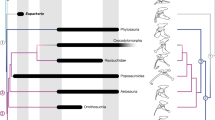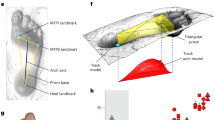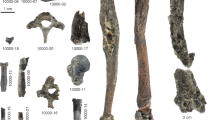Abstract
The nature of the hindlimb posture and gait of pterosaurs has been controversial1,2,3,4,5,6,7,8,9,10,11,12,13,14,15,16, partly because most of the pterosaur skeletons that have been found were flattened in thin-bedded rocks, therefore obscuring three-dimensional anatomy. A major controversy concerns the extent to which pterosaurs move on the ground; they have been variously interpreted as ranging from sprawling, quadrupedal walkers to erect, bird-like bipedal cursors1. Study of pelvis and femur material from the derived group Pterodactyloidea11,12,13 has resolved which movements are possible at the hip, but the lack of three-dimensional, articulated pterosaur feet has prevented examination of all of the movements that are possible within the foot. We have found a large, uncrushed, partial skeleton of a new species of the basal pterosaur Dimorphodon in thick-bedded deposits of Tamaulipas, Mexico; this material includes such a three-dimensional foot. The nature of this skeleton contradicts an important part of the cursorial interpretation, that is, that only the toes contacted the ground during terrestrial locomotion2,3,4,5,6,7. The flattened metatarsal–phalangeal joint at the base of the first four toes of this specimen would not allow such a digitigrade posture without separating most of the joints. A flat-footed stance is consistent with presumed footprints of pterosaurs8,9,10 that show impressions of the entire sole of the foot.
This is a preview of subscription content, access via your institution
Access options
Subscribe to this journal
Receive 51 print issues and online access
$199.00 per year
only $3.90 per issue
Buy this article
- Purchase on Springer Link
- Instant access to full article PDF
Prices may be subject to local taxes which are calculated during checkout





Similar content being viewed by others
References
Unwin, D. Pterosaur locomotion: joggers or waddlers? Nature 327, 13–14 (1987).
Padian, K. Osteology and functional morphology of Dimorphodon macronyx (Buckland) (Pterosauria: Rhamphorhynchoidea) based on new material in the Yale Peabody Museum. Postilla 189, 1–44 (1983).
Padian, K. Afunctional analysis of flying and walking in pterosaurs. Paleobiology 9, 218–239 (1983).
Padian, K. in Biomechanics in Evolution Sem. Ser. Soc. Exp. Biol. 36 (eds Rayner, J. M. V. & Wootton, R.J.) 145–160 (Cambridge Univ. Press, 1991).
Padian, K. & Rayner, J. V. The wings of pterosaurs. Am. J. Sci. 239-A, 91–166 (1993).
Sereno, P. Basal archosaurs: phylogenetic relationships and functional implications. J. Vert. Paleontol. 11, (suppl. to no. 4) 1–53 (1991).
Padian, K. in Short Papers Third Symp. Mesozoic Terrestrial Ecosystems (eds. Reif, W.-E. & Westphal, F.) 163–168 (Attempto, Tübingen, 1984).
Mazin, J., Hantzpergue, P., Lafaurie, G. & Vignaud, P. Des pistes de ptérosaures dans le Tithonien de Crayssac (Quercy, France). C.R. Acad. Sci. II, Sci. Terr. et Planet 321, 417–424 (1995).
Lockley, M. G.et al. The fossil trackway Pteraichnus is pterosaurian, not crocodilian: implications for the global distribution of pterosaur trackways. Ichnos 4, 7–20 (1995).
Bennett, S. C. Terrestrial locomotion of pterosaurs: a reconstruction based on Pteraichnus trackways. J.Vert. Paleontol. 17, 104–113 (1997).
Wellnhofer, P. Terrestrial locomotion in pterosaurs. Hist. Biol. 1, 3–16 (1988).
Bennett, S. C. Apterodactyloid pterosaur from the Santana Formation of Brazil: implications for terrestrial locomotion. J. Vert. Paleontol. 10, 80–85 (1990).
Wellnhofer, P. The Illustrated Encyclopedia of Pterosaurs (Crescent, New York, 1991).
Unwin, D. New remains of the pterosaur Dimorphodon (Pterosauria: Rhamphorhynchoidea) and the terrestrial ability of early pterosaurs. Mod. Geol. 13, 57–68 (1988).
Bennett, S. C. The arboreal leaping theory of the origin of pterosaur flight. Hist. Biol. 29, 373–386 (1997).
Unwin, D. M. & Bakhurina, N. N. Sordes pilosus and the nature of the pterosaur flight apparatus. Nature 371, 62–64 (1994).
Clark, J., Montellano, M., Hopson, J. & Fastovsky, D. in In the Shadow of the Dinosaurs (eds Fraser, N. & Sues, H.-D.) 295–302 (Cambridge, New York, 1994).
Fastovsky, D.et al. Depositional environments of a Middle Jurassic terrestrial vertebrate assemblage, Huizachal Canyon,Mexico. J. Vert. Paleontol. 15, 561–575 (1995).
Owen, R. Monograph of the Fossil Reptilia of the Liassic Formations I.Part III (Palaeontographical Society, London, 1870).
Galton, P. Arhamphorhynchoid pterosaur from the Upper Jurassic of North America. J. Paleontol. 55, 1117–1122 (1981).
Kellner, A. W. Description of New Material of Tapejaridae and Anhangueridae (Pterosauria, Pterodactyloidea) and Discussion of Pterosaur Phylogeny. Thesis, Columbia Univ.(1996).
Unwin, D. in Short Papers Sixth Symp. Mesozoic Terrestrial Ecosystems and Biota (eds Sun, A. & Wang,Y.) 69–72 (China Ocean, Beijing, 1995).
Wellnhofer, P. Pterosauria. Handbuch der Paläoherpetologie19 (Fischer, Stuttgart, 1978).
Wild, R. Die flugsaurier (Reptilia, Pterosauria) aus der oberen Trias von Cene bei Bergamo, Italien. Boll. Soc. Paleo. Ital. 17, 176–256 (1978).
Acknowledgements
This work was supported by the National Geographical Society and National Science Foundation. We thank the Huizachal Ejido and the Consejo Estatal para la Cultura y las Artes de Estado de Tamaulipas for permission to collect fossils in Huizachal Canyon; the Instituto de Geologia of U.N.A.M. for support; the Instituto Nacional de Antropologia e Historia for permission to borrow the specimen; C.Vanderslice, D. Chaney, and A. Davidson for fossil preparation; M. Ellison, M. Parrish and C.Vanderslice for illustrations; L. Grande and those who helped collect the fossil; M. Lockley, K.Padian, S. Gatesy, R. Blob, M. Carrano, F. A. Jenkins Jr., J. Gauthier, and S. Swartz for comments and the Field Museum of National History, the National Museum of Natural History, and the Natural History Museum, London for access to specimens.
Author information
Authors and Affiliations
Corresponding author
Rights and permissions
About this article
Cite this article
Clark, J., Hopson, J., Hernández R., R. et al. Foot posture in a primitive pterosaur. Nature 391, 886–889 (1998). https://doi.org/10.1038/36092
Received:
Accepted:
Issue Date:
DOI: https://doi.org/10.1038/36092
This article is cited by
-
Caelestiventus hanseni gen. et sp. nov. extends the desert-dwelling pterosaur record back 65 million years
Nature Ecology & Evolution (2018)
-
The origin and early evolution of birds: discoveries, disputes, and perspectives from fossil evidence
Naturwissenschaften (2004)
-
The smallest known non-avian theropod dinosaur
Nature (2000)
-
The vertebrate track record
Nature (1998)
Comments
By submitting a comment you agree to abide by our Terms and Community Guidelines. If you find something abusive or that does not comply with our terms or guidelines please flag it as inappropriate.



